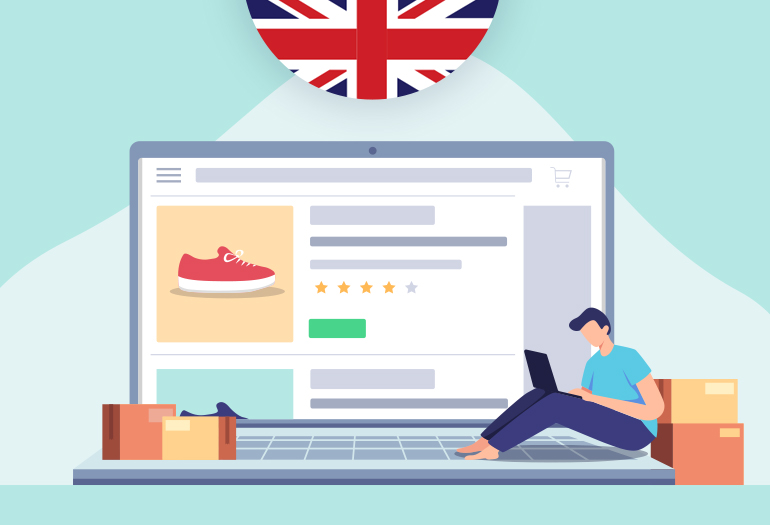

Online, product content serves as your packaging, 30-second commercial, promotional display, and more. Profitero’s research shows that having complete, correct and compelling content on the digital shelf can boost sales, traffic and conversion. In fact, we found brands get an average sales lift of 36% on Amazon in the U.K. when adding videos to product detail pages (PDPs) to meet category benchmarks. Adding more images yields a 34% average sales lift.
But one size doesn’t fit all when it comes to retail content management. What brands can actually do or have control over differs across retailer websites. Furthermore, what retailers require from vendors (typically via vendor scorecards) differs from retailer to retailer. In this blog, we highlight the product content capabilities of 6 highly trafficked eCommerce sites in the U.K. — Amazon, Argos, John Lewis, Ocado, Sainsbury’s and Tesco — comparing and contrasting what you can and can’t do.
A quick look at the different content capabilities supported by retailer websites
Source: Profitero
|
Amazon U.K. (1P) |
Argos |
John Lewis |
Ocado |
Sainsbury's |
Tesco |
|
|
Multiple images on product page |
Y |
Y |
Y |
Y |
Y |
Y |
|
Cambridge mobile hero images |
Y |
Y |
Y |
Y |
Y |
Y |
|
Spin 360 images |
Y |
Y |
N |
Y |
N |
N |
|
Videos on product page |
Y |
Y |
Y |
Y |
Y |
N |
|
Below-the-fold enhanced content |
Y |
Y |
N |
N |
N |
N |
|
Customer Q&A section |
Y |
Y |
N |
N |
N |
N |
|
Customer testimonial videos |
Y |
Y |
Y |
N |
N |
N |
One notable observation: Despite the U.K. having a big jump on Click & Collect versus the more recent pandemic-induced adoption in the U.S., Tesco and Sainsbury’s — arguably two of the biggest and most influential U.K. grocers — are light years behind some U.S. retailers, e.g., Target, in terms of content capabilities supported on their respective websites. (See our U.S. content cheat sheet.)
Let’s dig in deeper, highlighting some examples to show what brands can / can’t do with product content on these U.K. eCommerce sites. We’ll also offer some pro tips as you think about your retail content management.
Retail Content Management: Above-the-fold images and videos
Amazon: Amazon in the U.K. provides a ton of space to add multiple images and videos above the fold, so take full advantage of it. Our SEO research finds a high correlation between the number of images on Amazon and a high search ranking.
PRO TIPS:
- Aim to have at least 5 images for grocery and 7 images for general merchandise-type products on Amazon product detail pages (PDPs) in the U.K.; these are good benchmarks according to our research
- Make sure your hero image (the primary image in your carousel, on your PDP, and in search results) is a front-of-pack shot on a white background as required by Amazon
- Use different image types (e.g., out-of-box display; product usage; lifestyle imagery; scale and proportion; etc.) to build your narrative
- Order images so those with the highest conversion potential — i.e., best features, benefits, etc. — appear early; this is because only the first 7 (or 6 plus a video) are shown on the PDP (Note: Remaining images are viewable by clicking on the image gallery)
- Leverage spin 360 images for products and categories where it makes sense; spin 360 lets consumers virtually interact with a product, rotating it to view from different angles. Some brands have seen up to an 85% lift in conversion rate using spin 360, according to our research.
PRO TIP: Aim to have at least 5 images (and different types) in GROCERY on Amazon
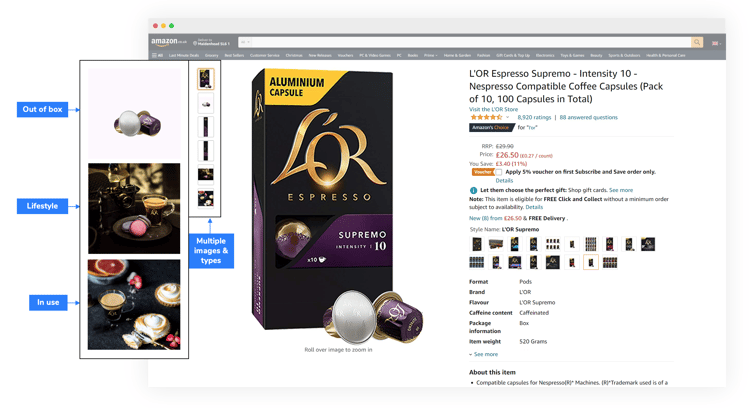
PRO TIP: Aim to have at least 7 images in GENERAL MERCHANDISE on Amazon
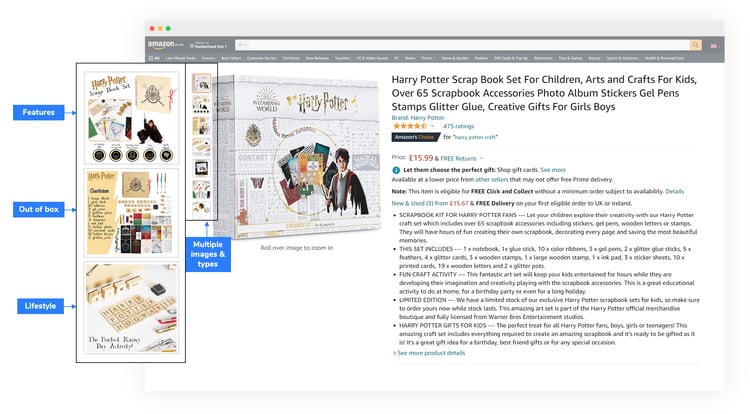
PRO TIP: Pay attention to the order of your images on Amazon
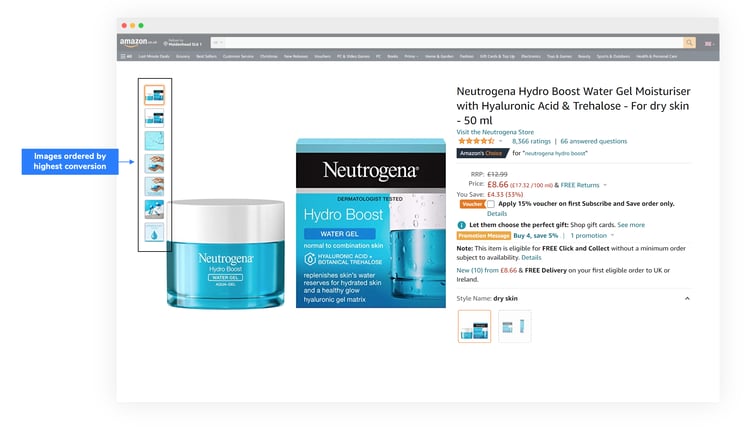
PRO TIP: Leverage the spin 360 capability on Amazon
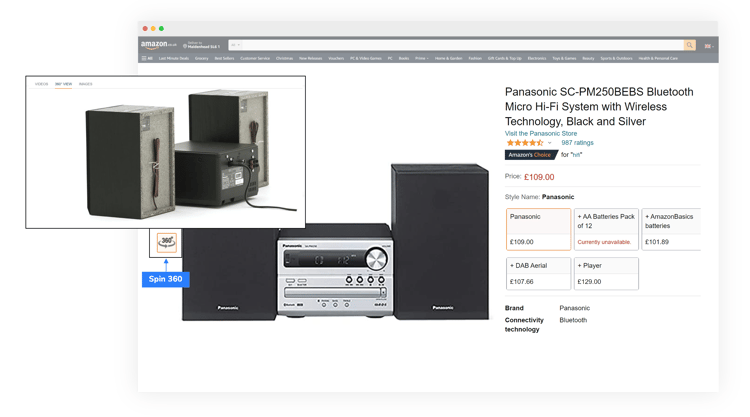
Argos: Brands can add a lot of content on Argos, fundamentally as much as on Amazon. Our SEO research finds the number of images on Argos.com and high search rank are somewhat correlated.
PRO TIPS:
- Aim for 6-7 images (depending on the product category) on Argos PDPs, according to our benchmark research
- Use spin 360 images for products where it makes sense, e.g., so shoppers can see all views and features of the product as if they were in the store
- While shoppers have the ability to scroll through all images on the PDP (without clicking), ordering images with high-conversion potential early on is always a good idea
PRO TIP: Leverage spin 360 images — a differentiating capability — on Argos
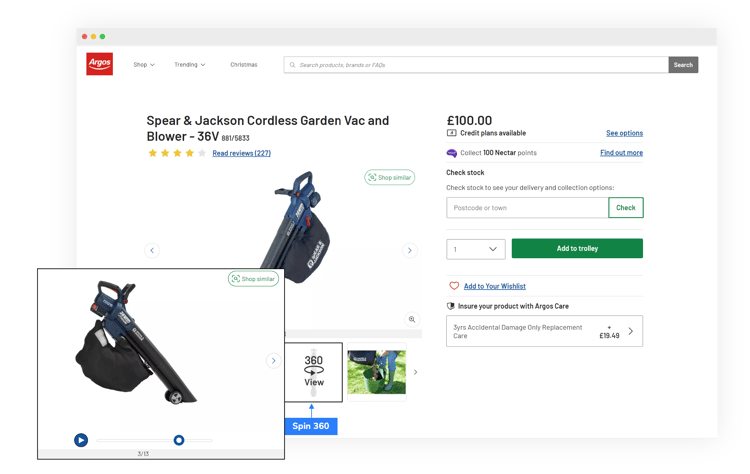
John Lewis: John Lewis supports multiple images and videos, including consumer-generated images. But unlike on Amazon and Argos, spin 360 is not currently supported. Importantly, our SEO research finds a high correlation between the number of images on John Lewis’ site and high search ranking.
PRO TIPS:
- Aim for 3-6 images (depending on the product category) on your John Lewis PDPs, according to our benchmark research
- Add videos to demonstrate product features and use cases
- Get shoppers to share photos of your brand on Instagram and tag @johnlewis; these consumer-generated images could end up being featured on the retailer’s website
PRO TIP: Use multiple images & videos to tell your brand story on John Lewis
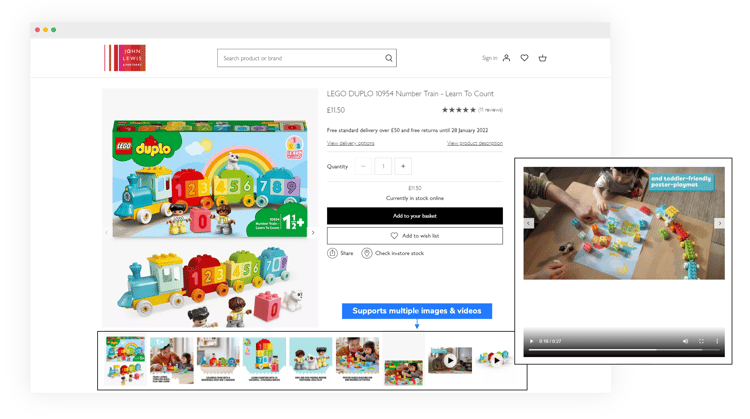
PRO TIP: Encourage shoppers to share on Instagram for a shot at being featured on John Lewis
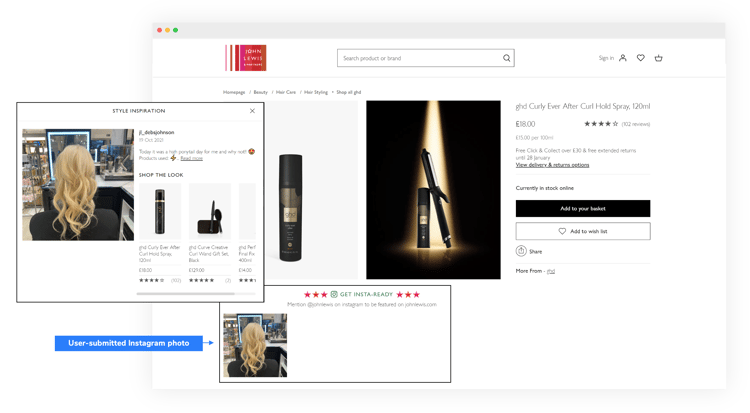
Ocado: Our SEO research on top U.K. grocery sites found a high correlation between the number of images on Ocado PDPs and high search ranking. Multiple images, image types (including spin 360) and videos are supported.
PRO TIPS:
- Aim for at least 3 images on your Ocado PDPs, according to our benchmark research
- Leverage different image types as well as video to tell your brand story
- Use feature icons (organic, vegetarian, etc.) on Ocado to set your products apart
PRO TIP: Feature different types of images & video on Ocado
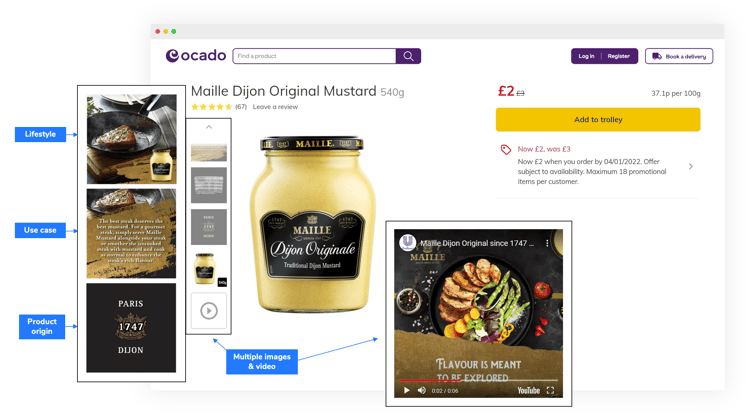
PRO TIP: Use feature icons on Ocado
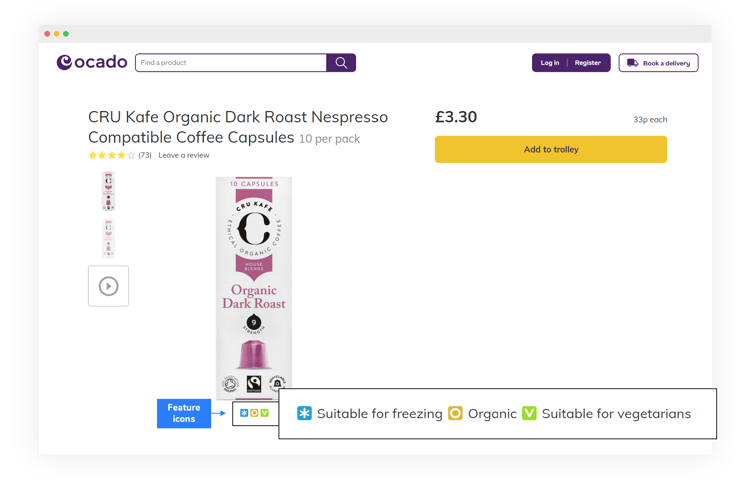
Tesco and Sainsbury’s: Despite being some of the nation’s frontrunners in Click & Collect, brands tend to be somewhat limited in what they can do content-wise on Tesco and Sainsbury’s. PDPs on both sites are rather basic looking, with many products having just a few images (1-3) each. Sainsbury’s allows videos; Tesco does not. Both, however, support Cambridge mobile hero images — a smart choice given the rapid rise in mobile shopping.
PRO TIPS:
- Nail your hero image on Tesco and Sainsbury’s sites, especially since other content options are somewhat limited
- Use a mobile-optimised hero image across platforms (laptop and mobile) to help shoppers quickly recognise your brand / product and key features: product type, variant, size / quantity, etc.
- Place Average Star Rating (with a link to reviews or link to add a review) front and center, above the fold on your PDPs; Our SEO research on U.K. grocery sites found a high correlation between the number of reviews and a high search ranking on both Tesco and Sainsbury’s
- Use video on Sainsbury’s site to help convey your brand story, demonstrate product uses, or share recipes
PRO TIP: Nail your hero image on Tesco and Sainsbury’s; better yet, optimise for mobile
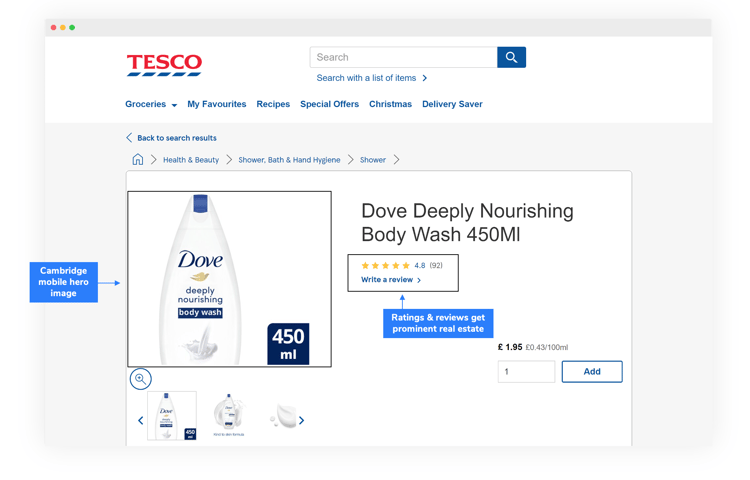
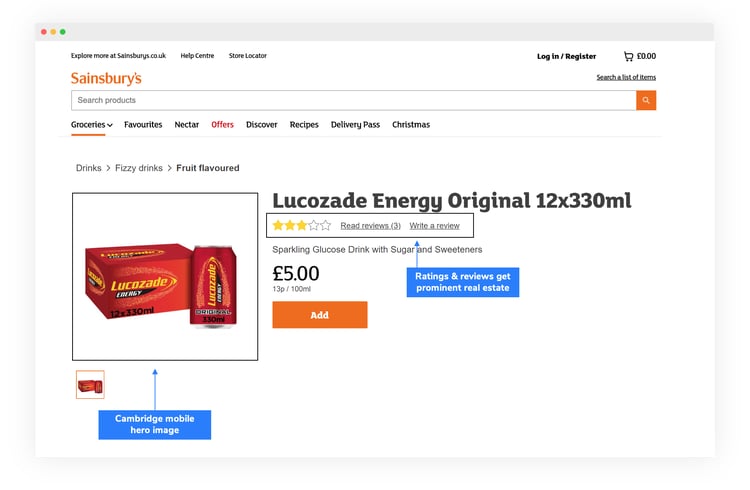
PRO TIP: Add video to product pages on Sainsbury’s
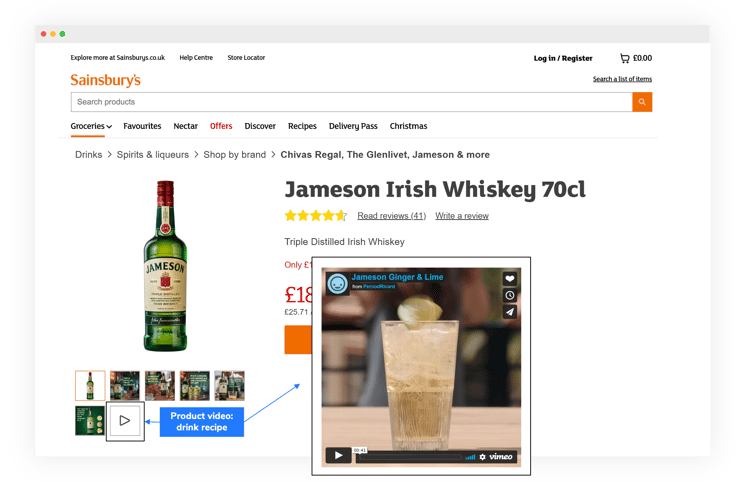
Retail Content Management: Below-the-fold A+ / Enhanced Manufacturer Content
Enhanced content (or A+ content on Amazon specifically) is the supplementary content supplied by manufacturers typically positioned “below the fold” or about halfway down a product detail page. Examples include additional images and videos, product comparison grids, decision guides, and manufacturer Q&A. According to our research, brands can get a 23% average sales lift on Amazon in the U.K. by improving A+ content to meet category benchmark standards.
Below are some examples of what you can do with below-the-fold enhanced content on different retailer sites to help support conversion and lift sales. At present, of the 6 U.K. eComm sites studied, only Amazon and Argos have full below-the-fold enhanced content capabilities.
Amazon PRO TIP: Take advantage of all Amazon capabilities in order to provide as much information as possible to online shoppers.
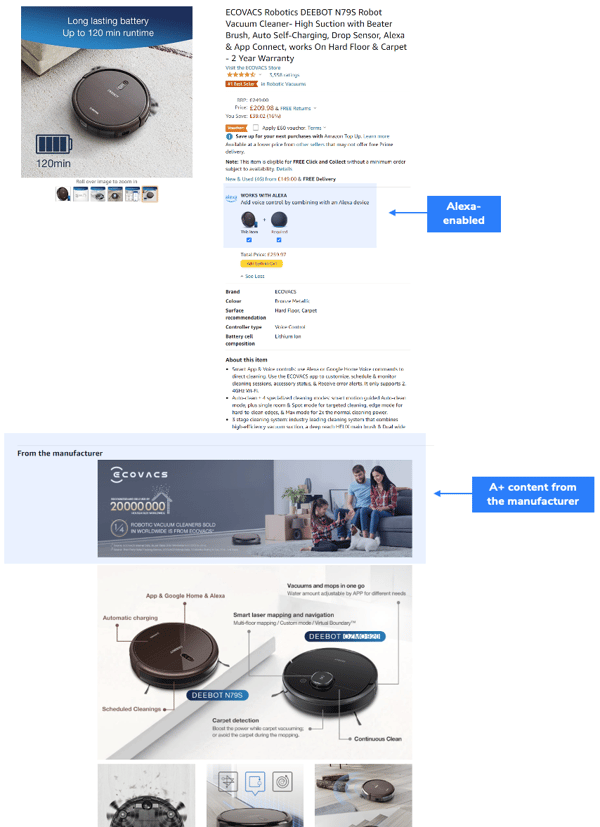
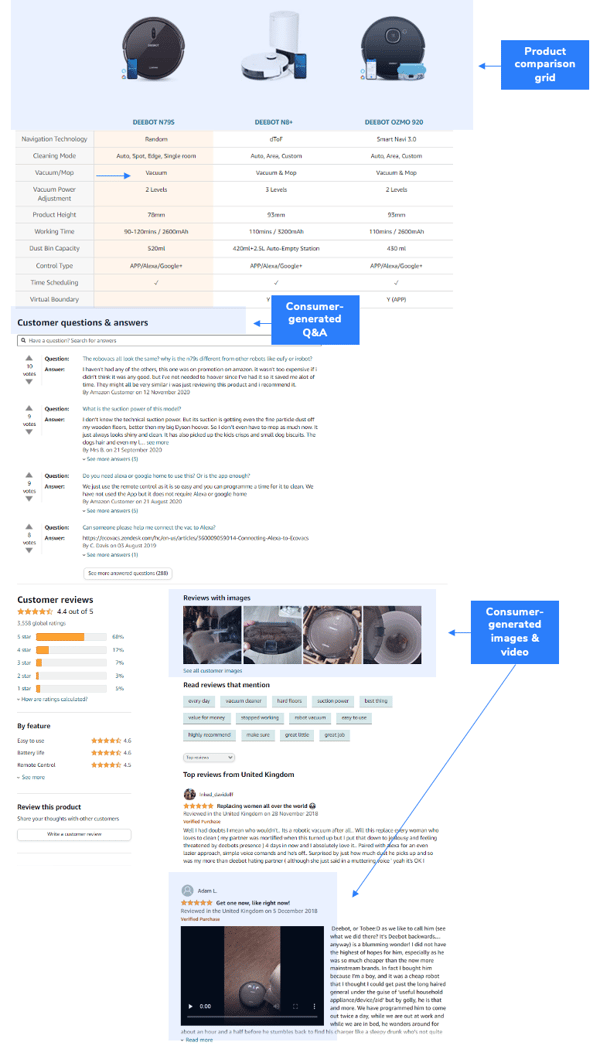
Argos PRO TIP: Add product details “from the manufacturer” (e.g., item attributes, comparison grids, guidebooks, additional videos, etc.), and leverage Q&A — both manufacturer FAQs and consumer-generated questions — to help ease the online shopping process.
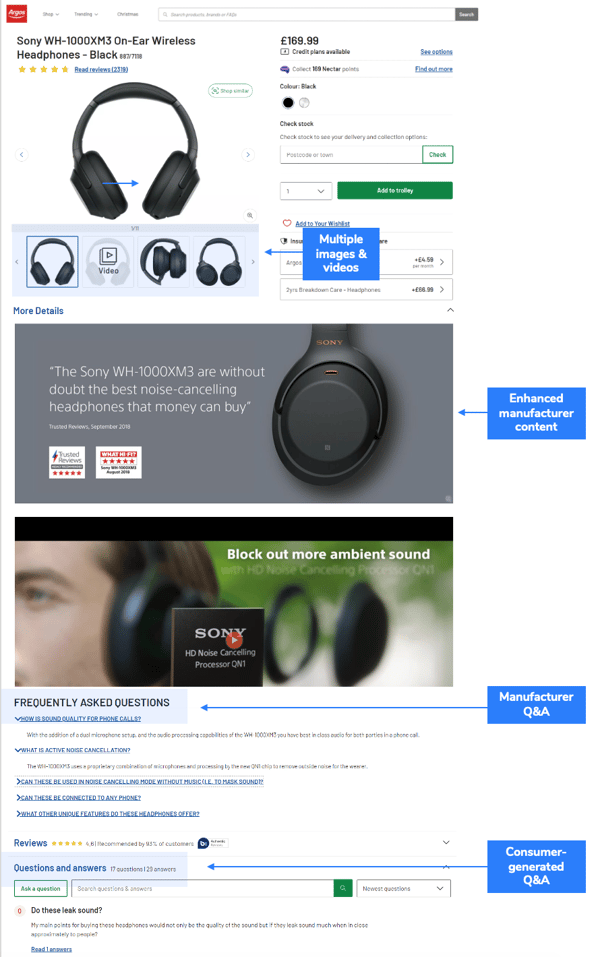
Ocado PRO TIP: Ocado (like Tesco and Sainsbury’s) doesn’t currently support rich media below-the-fold, so make the most of what you can do. For example, be sure to leverage the icons available on Ocado to help shoppers identify important product attributes, e.g., organic, suitable for freezing or microwave, suitable for vegetarians, etc.
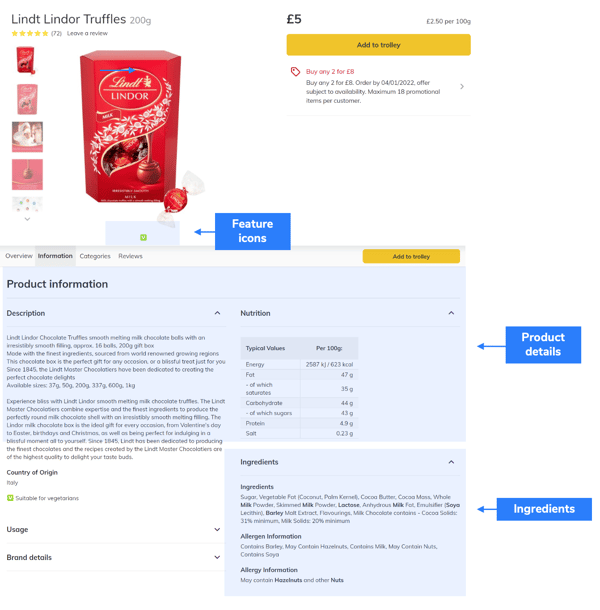
So what? Now what?
- Start with the basics. Ensure content elements on your product detail pages meet benchmark standards, including your own internally established rules and your retailers’ vendor scorecards. Benchmark against competitors and/or bestsellers in your category to ensure your content adequately stacks up.
- Nail hero images on sites where it matters. Some eCommerce sites — of the ones we analysed: Argos, Ocado, Sainsbury’s and Tesco — allow shoppers to buy or “add to trolley” directly from the search results page, so consumers may never even go to your PDP. This makes nailing your hero image, which shows up in search results, all the more important on these sites.
- Monitor, measure & syndicate. Invest in automated tools (e.g., Product Information Management / Digital Asset Management (PIM/DAM); digital shelf auditing tools; etc.) to build a cost-effective approach to monitoring, measuring and refreshing content.
- Establish retailer-specific scorecards. There’s no one size fits all when it comes to retail content management, so using a standard scorecard across all retailers to gauge your performance won’t work either. Our SEO research also finds that different metrics matter for different retailers. So it’s good practice to establish retailer-specific scorecards that (1) account for each retailer’s individual content capabilities, and (2) are appropriately weighted to what moves the needle on a particular retailer’s site.
- Optimise content for conversion. Designate team members (either internally or at an agency partner) to identify optimisation and ROI improvement opportunities; The application of advanced analytics or AI technologies to do real-time A/B testing of product visuals before they hit the digital shelf could be worth the investment.
Contact us to learn more about how Profitero’s insights can help you manage and optimise your product content across different retailer sites.


























